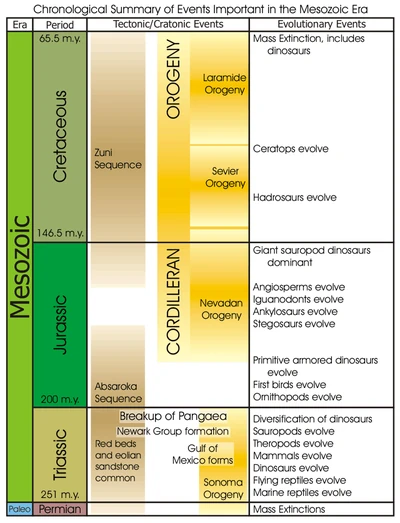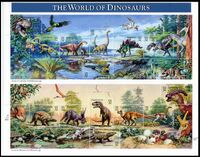
The Mesozoic Era is one of three geologic eras of the Phanerozoic eon. The division of time into eras dates back to Giovanni Arduino, in the 18th century, although his original name for the era now called the 'Mesozoic' was 'Secondary' (making the modern era the 'Tertiary'). Lying between the Paleozoic and the Cenozoic, Mesozoic means 'middle animals', derived from Greek prefix meso-/μεσο- for 'between' and zoon/ζωον meaning animal or 'living being'. It is often called the 'Age of Medieval Life' or the 'Age of the Dinosaurs', after the dominant fauna of the era.
The Mesozoic was a time of tectonic, climatic and evolutionary activity. The continents gradually shifted from a state of connectedness into their present configuration, this rifting providing for speciation and other important evolutionary developments. The climate was exceptionally warm throughout the period, also playing an important role in the evolution and diversification of new animal species. By the end of the era, the basis of modern life was in place.
Geologic Periods[]

Following the Paleozoic, the Mesozoic extended roughly 180 million years: from 251 million years ago (Mya) to when the Cenozoic era began 65 Mya. This time frame is separated into three geologic Periods. From oldest to youngest:
- Triassic (251.0 Ma to 199.6 Ma)
- Jurassic (199.6 Ma to 145.5 Ma)
- Cretaceous (145.5 Ma to 65.5 Ma)
The lower (Triassic) boundary is set by the P-T extinction event, during which approximately 90% of marine species and 70% of terrestrial vertebrates became extinct. It is also known as the "Great Dying" because it is considered the largest mass extinction in history. The upper (Cretaceous) boundary is set at the Cretaceous-Tertiary (KPg) extinction, which may have been caused by the meteor that created the Chicxulub Crater on the Yucatán Peninsula. Approximately 50% of all genera became extinct, including all of the non-avian dinosaurs.
Tectonics[]
After the vigorous convergent plate mountain-building of the late Paleozoic, Mesozoic tectonic deformation was comparatively mild. Nevertheless, the era featured the dramatic rifting of the supercontinent Pangea. Pangea gradually split into a northern continent, Laurasia, and a southern continent, Gondwana. This created the passive continental margin that characterizes most of the Atlantic coastline (such as along the U.S. East Coast) today.(Stanley, 456-8)
By the end of the era, the continents had rifted into nearly their present form. Laurasia became North America and Eurasia, while Gondwana split into South America, Africa, Australia, Antarctica and the Indian subcontinent, which collided with the Asian plate, during the Cenozoic, the impact giving rise to the Himalayas.
Mesozoic climate[]
The Triassic was generally dry, a trend that began in the late Carboniferous, and highly seasonal, especially in the interior of Pangea. Low sea levels may have also exacerbated temperature extremes. Water acts as a temperature-stabilizing heatsink due to its high specific heat capacity, and land areas near large bodies of water, especially the oceans, experience less variation in temperature. Because much of the land that constituted Pangea was distant from the oceans, temperatures fluctuated enormously, and the interior of Pangea probably included expansive areas of desert. Abundant evidence of red beds and evaporites such as salt support these conclusions.
Sea levels began to rise during the Jurassic, probably due to an increase in seafloor spreading. The formation of new crust beneath the surface displaced ocean waters by as much as 200 m more than today, which flooded coastal areas. Furthermore, Pangea began to rift into smaller divisions, bringing more land area in contact with the ocean by forming the Tethys Sea. Temperatures continued to increase and began to stabilize. Humidity also increased with the proximity of water, and deserts retreated.
The climate of the Cretaceous is less certain and more widely disputed. Due in part to higher levels of carbon dioxide in the atmosphere, the world temperature gradient from North to South became almost flat: temperatures were about the same across the planet. Average temperatures were also higher than today, about 10 °C. In fact, by the middle Cretaceous, equatorial ocean waters, perhaps as warm as 20 °C in the deep ocean, may have been too warm for sea life and land areas near the equator may have been deserts despite their proximity to water. The circulation of oxygen to the deep ocean may also have been disrupted. For this reason, large volumes of organic matter accumulated, because they were unable to decompose and were eventually deposited as "black shale".
Not all of the data support these hypotheses, however. Even with the overall warmth, temperature fluctuations should have been sufficient for the presence of polar ice caps and glaciers, but there is no evidence of either. Quantitive models have also been unable to recreate the flatness of the Cretaceous temperature gradient.
Mesozoic life[]
The extinction of nearly all animal species at the end of the Permian period allowed for the radiation of many new lifeforms. In particular, the extinction of the large herbivorous and carnivorous dinocephalia left those ecological niches empty. Some were filled by the suriving cynodonts and dicynodonts, the latter of which subsequently became extinct. Animal life during the Mesozoic was dominated, however, by large archosaurian reptiles that appeared a few million years after the Permian extinction: dinosaurs, pterosaurs, and aquatic reptiles such as ichthyosaurs, plesiosaurs, and mosasaurs.
The climatic changes of the late Jurassic and Cretaceous provided for further adaptive radiation. The Jurassic was the height of archosaur diversity, and the first birds and placental mammals also appeared. Angiosperms radiated sometime in the early Cretaceous, first in the tropics, but the even temperature gradient allowed them to spread toward the poles throughout the period. By the end of the Cretaceous, angiosperms dominated tree floras in many areas, although some evidence suggests that biomass was still dominated by cycad and ferns until after the KT extinction.
Some have argued that insects diversied with angiosperms because insect anatomy, especially the mouth parts, seems particularly well-suited for flowering plants. However, all major insect mouth parts preceded angiosperms and insect diversification actually slowed when they arrived, so their anatomy originally must have been suited for some other purpose.
As the temperatures in the seas increased, the larger animals of the early Mesozoic gradually began to disappear while smaller animals of all kinds, including lizards, snakes, and perhaps the ancestor mammals to primates, evolved. The KPg extinction exacerbated this trend. The large archosaurs became extinct, while birds and mammals thrived, as they do today.